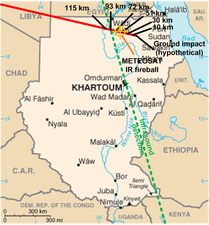2008 TC3

|
|
| Discovery | |
|---|---|
| Discovered by | Catalina Sky Survey |
| Discovery date | October 6, 2008, 06:39 UTC |
| Designations | |
| MPC designation | 2008 TC3 |
| Near-Earth object (NEO), Apollo asteroid | |
| Orbital characteristics | |
| Epoch 7 October 2008 (JD 2454746.5) | |
| Uncertainty parameter 4 | |
| Aphelion | 1.71644 AU (256.776 Gm) |
| Perihelion | 0.899957 AU (134.6317 Gm) |
| 1.308201 AU (195.7041 Gm) | |
| Eccentricity | 0.312065 |
| 1.50 yr (546.53 d) | |
| 330.7541° | |
| 0.6587071°/day | |
| Inclination | 2.54220° |
| 194.101138° | |
| 234.44897° | |
| Jupiter MOID | 3.57975 AU (535.523 Gm) |
| Physical characteristics | |
| Dimensions | 4.1 meters |
| Mass | 80,000 kg (8*104 kg) |
|
Mean density
|
~1.5 g/cm3 |
| 0.0269409 h (1.61645 min) | |
| 0.1 ±0.03 | |
| F/M | |
| 30.4 | |
|
|
|
|
|
|
|
|
2008 TC3 (Catalina Sky Survey temporary designation 8TA9D69) was an 80 metric tons (80 long tons; 90 short tons), 4.1 meters (13 ft) diameter asteroid that entered Earth's atmosphere on October 7, 2008. It exploded at an estimated 37 kilometers (23 mi) above the Nubian Desert in Sudan. Some 600 meteorites, weighing a total of 10.5 kilograms (23.1 lb), were recovered; many of these belonged to a rare type known as ureilites, which contain, among other minerals, nanodiamonds.
It was the first time that an asteroid impact had been predicted prior to its entry into the atmosphere as a meteor.
The asteroid was discovered by Richard A. Kowalski at the Catalina Sky Survey (CSS) 1.5-meter telescope at Mount Lemmon, north of Tucson, Arizona, US, on October 6, 06:39 UTC, 19 hours before the impact.
It was notable as the first such body to be observed and tracked prior to reaching Earth. The process of detecting and tracking a near-Earth object, an effort sometimes referred to as Spaceguard, was put to the test. In total, 586 astrometric and almost as many photometric observations were performed by 27 amateur and professional observers in less than 19 hours and reported to the Minor Planet Center, which issued 25 Minor Planet Electronic Circulars with new orbit solutions in eleven hours as observations poured in. On October 7, 01:49 UTC, the asteroid entered the shadow of the Earth, which made further observations impossible.
Impact predictions were performed by University of Pisa's CLOMON 2 semi-automatic monitoring system as well as Jet Propulsion Laboratory's Sentry system. Spectral observations that were performed by astronomers at the 4.2-meter William Herschel Telescope at La Palma, Canary Islands are consistent with either a C-type or M-type asteroid.
...
Wikipedia
